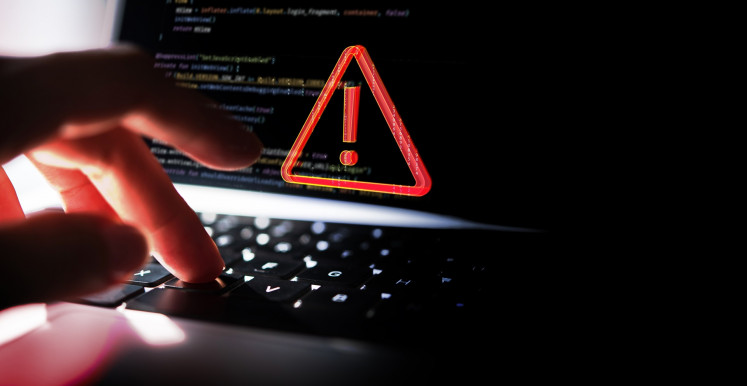Popular Reads
Top Results
Can't find what you're looking for?
View all search resultsPopular Reads
Top Results
Can't find what you're looking for?
View all search resultsThe origins of intolerance to ward Ahmadiyah
This week marks the one-year anniversary of the tragedy of Cikeusik in Banten, when members of the Cikeusik Muslim Movement killed three members of the Muslim-minority sect Ahmadiyah
Change text size
Gift Premium Articles
to Anyone
T
his week marks the one-year anniversary of the tragedy of Cikeusik in Banten, when members of the Cikeusik Muslim Movement killed three members of the Muslim-minority sect Ahmadiyah. Since then, Indonesian human rights organizations have launched a conversation about the place of religious tolerance in society.
Unfortunately, this conversation is rife with uncertainty. The origins of intolerance to ward Ahmadiyah, the attitudes of the civil society organizations Nahdlatul Ulama (NU) and Muhammadiyah toward Ahmadiyah, and the state policies toward Ahmadiyah are poorly understood. This ambiguity makes it difficult to pinpoint the cause of the violence, let alone try and stop the violence.
In explaining the origins of contemporary intolerance toward Ahmadiyah, most commentators point to 2005, when the Indonesian Ulema Council (MUI) reissued their fatwa (edict) declaring Ahmadiyah a deviant sect. Yet polemics against Ahmadiyah began much earlier.
The famous Islamic reformer Hamka reports that his father, Haji Rasul, launched the first polemic against Ahmadiyah in Yogyakarta in 1925. The charges against Ahmadiyah were that they followed a prophet other than Muhammad and that they denied the death of the Prophet Jesus.
These charges were repeated in Pembela Islam magazine throughout the 1930s, and by self-proclaimed Anti-Ahmadiyah groups connected to Persatuan Islam (Persis) and established in Bandung, Bogor, Medan, Padang, Priok, Leles, Ciledug, Cirebon, Gorontalo and Garut. Pembela Islam called Ahmadiyah members as deviant (sesat), apostates (murtad), infidels (kafir), crazy, and labeled Mirza Ghoelam Ahmad a false prophet.
These polemics were not limited to Islamic reformers like Persis. President Sukarno denounced Ahmadiyah, stating that while he admired them for their modernism, they were also “devoted to British imperialism”. NU’s magazine reprinted an article from Pembela Islam denouncing Ahmadiyah. And NU used the question of Ahmadiyah to decry ijtihad, a method of Koranic interpretation involving setting aside past interpretations.
Abandoning past interpretations, NU argued, would inevitably lead to the kind of deviance seen among followers of Ahmadiyah. NU further protested the inclusion of an Ahmadiyah branch in the country’s first important Islamic political coalition, the Great Islamic Council of Indonesia (Al-Madjlisoel-Islamil-A’laa Indonesia, MIAI). NU ran a series of essays attempting to expose the Ahmadiyah movement for their alleged collusion with British imperialism and for Ghoelam Ahmad’s claim to prophecy.
In response, the MIAI excluded the Ahmadiyah branch. And after the MIAI was transformed into Masyumi, leaders of Masyumi staffed the Religious Affairs Ministry and again rejected the Ahmadiyah movement’s appeal for recognition. Rather than being a recent development, history suggests that intolerance toward Ahmadiyah precedes the establishment of the state.
Muhammadiyah and NU are widely seen as the backbone of Indonesia’s culture of tolerance. Yet, they have not protected members of Ahmadiyah, something most commentators attribute to their inability to combat the militants.
This assumption is inaccurate. Survey data that I collected in 2010 with branch-level leaders of Muhammadiyah and NU demonstrates that an overwhelming majority do not believe members of Ahmadiyah should be allowed to hold public office, build houses of worship, or teach in schools.
The data revealed that 75 percent of Muhammadiyah leaders and 59 percent of NU leaders say no members of Ahmadiyah should be allowed to become the mayor in Jakarta; 80percent of Muhammadiyah leaders and 67 percent of NU leaders say that no members of Ahmadiyah should be allowed to build a house of worship in Jakarta; 88 percent of Muhammadiyah leaders and 82 percent of NU leaders say that no members of Ahmadiyah should be permitted to teach Islamic studies in public schools.
These views are not indicative of endemic intolerance; those same leaders believe that Christians, Hindus and Buddhists are entitled to religious and political freedom. The closest parallel to their intolerance of Ahmadiyah is in their views of the rights of Communists.
This similarity between Ahmadiyah and Communists points to the most important reason why intolerance toward Ahmadiyah has persisted for decades; state policy, specifically long-standing policies promulgated by the Religious Affairs Ministry with the backing of NU and Muhammadiyah. Religion is a privileged category according to the ministry and syncretic movements like the Javanese kebatinan and heterodox movements like Ahmadiyah are denied recognition.
The ministry’s privileging of religious orthodoxy was given presidential sanction in 1965 when Sukarno passed a decree stating that there were only six officially recognized religions and that any group who threatened these religions would be dissolved. That decree is still in force; PNPS No. 1/1965 was upheld in 2010 by the Constitutional Court with the backing of the Religious Affairs Ministry, NU, Muhammadiyah, Persis, numerous political parties, the Confucian group Matakin, the Buddhist group Walubi, the Hindu group PHDI, MUI, and many conservative Islamic groups.
Most accounts of sectarian conflict in Indonesia argue that the issue of Ahmadiyah pits the peripheral militant Islamic groups against the majority of Indonesian moderates. Others point to the 2008 joint ministerial decree as fostering intolerance. This history and survey data suggest otherwise.
Anti-Ahmadiyah sentiment is broader and more deeply institutionalized than the shallow dichotomy between moderates and militants would suggest. The exclusion of Ahmadiyah is built into the structure of the Ministry of Religious Affairs.
Despite President Yudhoyono’s frequent speeches about tolerance, official state policy is that members of Ahmadiyah are not given the same protection as orthodox religions. The coalition backing the Constitutional Court decision, and survey data of NU and Muhammadiyah leaders, suggests that this policy has broad public support.
As a result, it should come as no surprise that the state and the police are unwilling to intervene to protect the lives of members of Ahmadiyah. While this does not mean that violence against Ahmadiyah members is inevitable, it does mean that institutional changes, such as to the Ministry of Religious Affairs, must be central to programs designed to reduce conflict.
The writer is a Shorenstein Postdoctoral Fellow at Stanford University, and will be an assistant professor of international relations at Boston University beginning in 2013.










